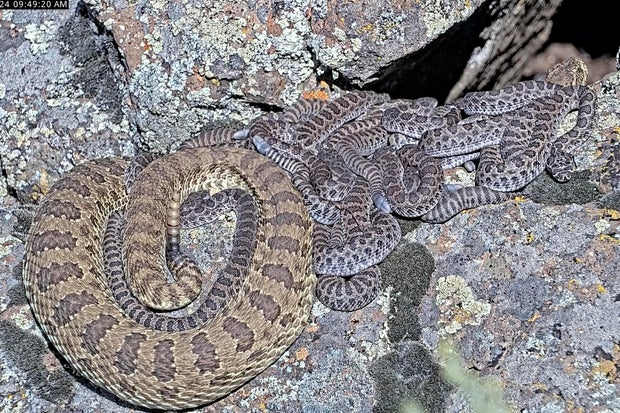A “mega den” of hundreds of rattlesnakes in Colorado is growing in size as summer arrives and young are born.
Thanks to livestreamed video, scientists studying a burrow on a rocky Colorado hillside are learning more about these enigmatic — and often misunderstood — reptiles. They watch as the young, called pups, slither over and between adult females on lichen-covered rocks.
The public can also watch on the Project RattleCam website and help with important work, including how to tell snakes apart. Since researchers put their remote camera online in May, several snakes have become known in a chat room and to scientists under names such as “Woodstock,” “Thea” and “Agent 008.”
The project is a collaboration between California Polytechnic State University in San Luis Obispo, snake control company Central Coast Snake Services and Dickinson College in Carlisle, Pennsylvania.
By involving the public, scientists hope to dispel the idea that rattlesnakes are typically ferocious and dangerous. In fact, experts say they rarely bite unless threatened or provoked, and often do just the opposite.
/AP
Rattlesnakes are not only among the few reptiles that care for their young. They even care for the young of others. The adults protect and provide body heat to the young from birth until they hibernate in mid-fall, according to Max Roberts, a graduate student researcher at CalPoly.
“We regularly see what we call ‘babysitting’ – pregnant females that we can clearly see have not yet given birth, but are guarding the newborn snakes,” Roberts said Wednesday.
About 2,000 rattlesnakes spend the winter at the site on private land, which researchers keep secret to discourage trespassers. When the weather warms, only the pregnant females remain, while the others disperse to nearby areas.
This year, scientists monitoring the Colorado site have watched the rattlesnakes coil and catch water to drink from the cups their bodies form. They’ve also watched the snakes react to birds that swoop in for a scaly meal.
According to the National Wildlife Federation, rattlesnakes are found almost everywhere in the continental United States, but experts often note that the snakes are difficult to study due to their rugged habitats and secretive behavior.
According to researchers, the best time to watch the live feed is in the morning or early evening. In addition, observations from the community are always welcome in the accompanying live chat of the YouTube feed.
The peak of summer is in late August and early September, when the rattlesnakes give birth to their young over a period of about two weeks.
“As soon as they’re born, they know how to go to the sun or the shade to regulate their body temperature,” Roberts said.
There are 36 species of rattlesnakes, most of which are found in the United States. They are found in almost all states and are particularly common in the Southwest. The species studied are prairie rattlesnakes, which are found in much of the central and western United States and in Canada and Mexico.
Like other vipers, but unlike most snakes, rattlesnakes do not lay eggs. Instead, they give birth to live young. Eight is an average brood, with the number depending on the size of the snake, Roberts said.
Roberts studies how temperature changes and ultraviolet sunlight affect snake behavior. Another doctoral student, Owen Bachhuber, studies the family and social relationships of rattlesnakes.
The researchers watch the live feed all day long, and they also get help from up to 500 people tuning in online at the same time.
“We’re interested in studying the natural behavior of rattlesnakes, without human disturbance. What do rattlesnakes actually do when we’re not there?” Roberts said.
As the Rocky Mountain summer cools, some males return. In November, the solar- and battery-powered camera is turned off until the following spring, when the snakes emerge from their “mega-den.”
Project Rattle Cam operates another livestream that tracks a smaller western rattlesnake den along California’s central coast. For the past three years, that feed has monitored the den during warmer seasons, when the snakes emerge from their hiding places, Cal Poly said. That stream, too, was set up at an undisclosed location and went live again on July 11.
Emily Mae Czachor contributed to this report.






